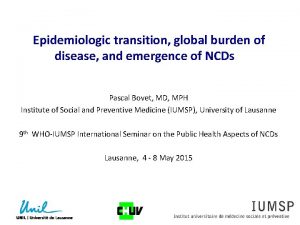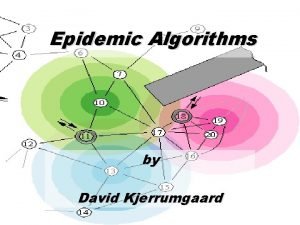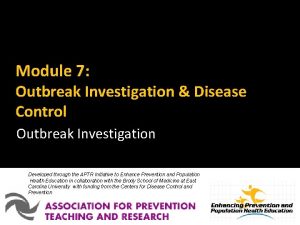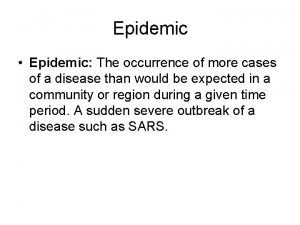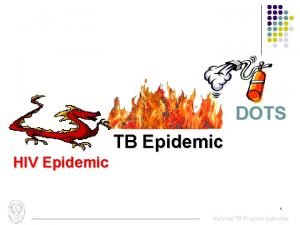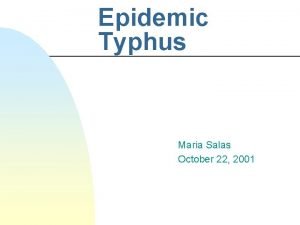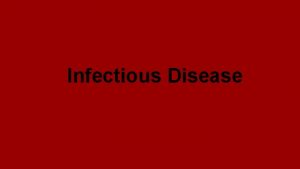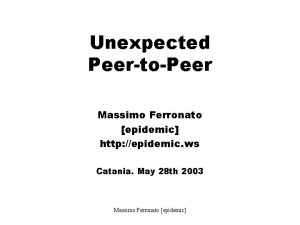Network Epidemic Feimi Yu 11292018 Recall of epidemic














- Slides: 14

Network Epidemic Feimi Yu 11/29/2018

Recall of epidemic models without network– basic states S I Infection R Removal Recovery Susceptible (healthy) Infected (sick) Removed (immune / dead) 2 Network Epidemic 3/8/2021

Recall of epidemic models without network– definitions § Each individual has <k> contacts (degrees) § Likelihood that the disease will be transmitted from an infected to a healthy individual in a unit time: β § Number of infected individuals: I. Infected ratio i = I/N § Number of susceptible individuals: S Susceptible ratio s = S/N 3 Network Epidemic 3/8/2021

Recall of epidemic models without network – comparisons I Infection Removal R Fraction Infected i(t) S Recovery Infected (sick) S Infection I Removed (immune / dead) R Removal Time (t) Fraction Infected i(t) Susceptible (healthy) Recovery Susceptible (healthy) S Infected (sick) Infection I Removed (immune / dead) Removal R Time (t) Recovery Susceptible (healthy) Infected (sick) Removed (immune / dead) 4 Network Epidemic 3/8/2021

Real networks are not homogeneous § Real contagions are regional − Individuals can transmit a pathogen only to those they come into contact with − Epidemics spread along links in a network § Real networks are often scale-free − Nodes have different dgrees − �k� is not sufficient to characterize the topology Homogeneous mixing model is not realistic! The black death pandemic 5 Network Epidemic 3/8/2021

Comparison between homogeneous mixing and real network 6 Network Epidemic 3/8/2021

Degree block approximation § Degrees is the only variable that matters in network epidemic model − Place all nodes that have the same degree into the same block − No elimination of the compartments based on the state of an individual − Independent of its degree an individual can be susceptible to the disease (empty circles) or infected (full circles). 7 Network Epidemic 3/8/2021

Network epidemic – SI model Split nodes by their degrees SI model: Average degree of the block k Density of infected I am susceptible with k neighbors, and Θk(t) neighbors of nodes with degree k of my neighbors are infected. 8 Network Epidemic 3/8/2021

Network epidemic– SI model § An ER random network with <k> = 2 § At any time, the fraction of high degree nodes that are infected is higher than the fraction of low degree nodes. § All hubs are infected at any time 9 Network Epidemic 3/8/2021

Network epidemic – SIS model Split nodes by their degrees SI model: Average degree of the block k Recovery term Density of infected I am susceptible with k neighbors, and Θk(t) neighbors of nodes with degree k of my neighbors are infected. Threshold λc 10 Network Epidemic 3/8/2021

Network epidemic– SIS model on random network 11 Network Epidemic 3/8/2021

Network epidemic– SIS model on scale-free network 12 Network Epidemic 3/8/2021

Comparison of the network epidemic models Model SI Continuum Equation τ λc SIS SIR 13 Network Epidemic 3/8/2021

Summary § Network epidemics behave very differently than simple epidemic models § Nodes with higher degree (hubs) are more vulnerable than those with lower degree § In SIS and SIR models, even pathogen with low spreading rate persists iin scale-free networks because of the broadcasting ability of the hubs 14 Network Epidemic 3/8/2021
 Epidemic dropsy
Epidemic dropsy Endemic epidemic
Endemic epidemic Doctors attributed the epidemic to the rampant
Doctors attributed the epidemic to the rampant Obesity and bone health
Obesity and bone health Epidemic broadcast trees
Epidemic broadcast trees Endemic epidemic
Endemic epidemic Epidemic dropsy
Epidemic dropsy Aids epidemic
Aids epidemic Network topology in computer network
Network topology in computer network Difference between circuit message and packet switching
Difference between circuit message and packet switching Features of peer to peer network and client server network
Features of peer to peer network and client server network Ece 526
Ece 526 Virtual circuit and datagram networks in computer networks
Virtual circuit and datagram networks in computer networks Network centric computing and network centric content
Network centric computing and network centric content Identification test type
Identification test type



